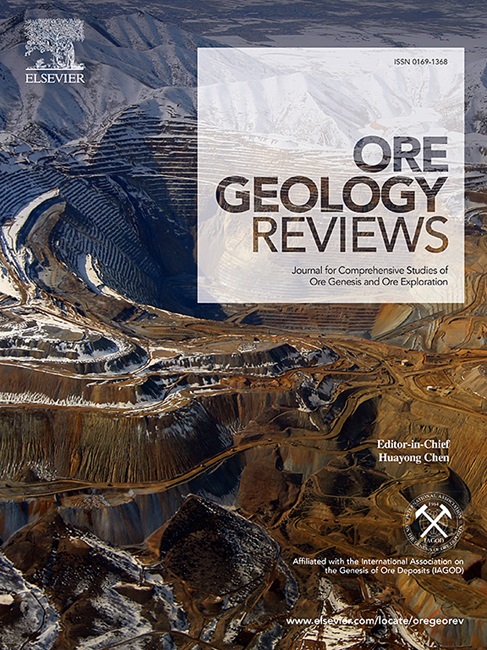Comment on “Mineralization age of the Xiangshan uranium ore field, South China redefined by hydrothermal apatite U-Pb geochronology” by Wang et al., (Ore Geology Reviews, 2023, https://doi.org/10.1016/j.oregeorev.2023.105586)
IF 3.2
2区 地球科学
Q1 GEOLOGY
引用次数: 0
Abstract
Recently,Wang et al., (2023) published their apatite U-Pb ages from Xiangshan uranium ore field, South China and concluded that uranium mineralization age is synchronously formed to the hosting rock. This conclusion presents a significant departure from traditional views and offers novel insights into the timing of uranium mineralization. This paper raises evidence based on our research results in Xiangshan area in the past decade. Firstly, field observations indicate that uraniferous veins cut the well crystallized volcanic complex, suggesting a later hydrothermal event. Additionally, the synchronicity of apatite formation with uranium enrichment is questioned, as type 2 apatite crystals show complex relationships with uranium minerals. Discrepancies in previous U-Pb dates on U-minerals and Ar-Ar dates are discussed as well, and the result suggests that the age of volcanic complex hosting uranium minerals is mainly concentrated between 130 and 145 Ma, and the time difference between mineralization and diagenesis varies greatly. The paper emphasizes the need to reconcile the differences between various dating methods to accurately determine the mineralization age.
评王等《热液磷灰石U-Pb年代学重新定义华南象山铀矿田成矿时代》(矿石地质评论,2023,https://doi.org/10.1016/j.oregeorev.2023.105586)
最近,Wang等(2023)公布了华南香山铀矿田磷灰石U-Pb年龄,认为铀矿化年龄与寄主岩同步形成。这一结论与传统观点有很大不同,并为铀矿化时间提供了新的见解。本文根据近十年来在象山地区的研究成果提出证据。首先,野外观测表明,含铀矿脉切断了结晶良好的火山杂岩体,表明岩浆热液事件发生较晚。此外,由于2型磷灰石晶体与铀矿物的关系复杂,磷灰石形成与铀富集的同步性也受到质疑。讨论了以往铀矿物U-Pb测年与Ar-Ar测年的差异,认为含铀矿物的火山杂岩年龄主要集中在130 ~ 145 Ma之间,成矿与成岩的时间差异较大。为了准确确定成矿年龄,必须协调各种测年方法之间的差异。
本文章由计算机程序翻译,如有差异,请以英文原文为准。
求助全文
约1分钟内获得全文
求助全文
来源期刊

Ore Geology Reviews
地学-地质学
CiteScore
6.50
自引率
27.30%
发文量
546
审稿时长
22.9 weeks
期刊介绍:
Ore Geology Reviews aims to familiarize all earth scientists with recent advances in a number of interconnected disciplines related to the study of, and search for, ore deposits. The reviews range from brief to longer contributions, but the journal preferentially publishes manuscripts that fill the niche between the commonly shorter journal articles and the comprehensive book coverages, and thus has a special appeal to many authors and readers.
 求助内容:
求助内容: 应助结果提醒方式:
应助结果提醒方式:


